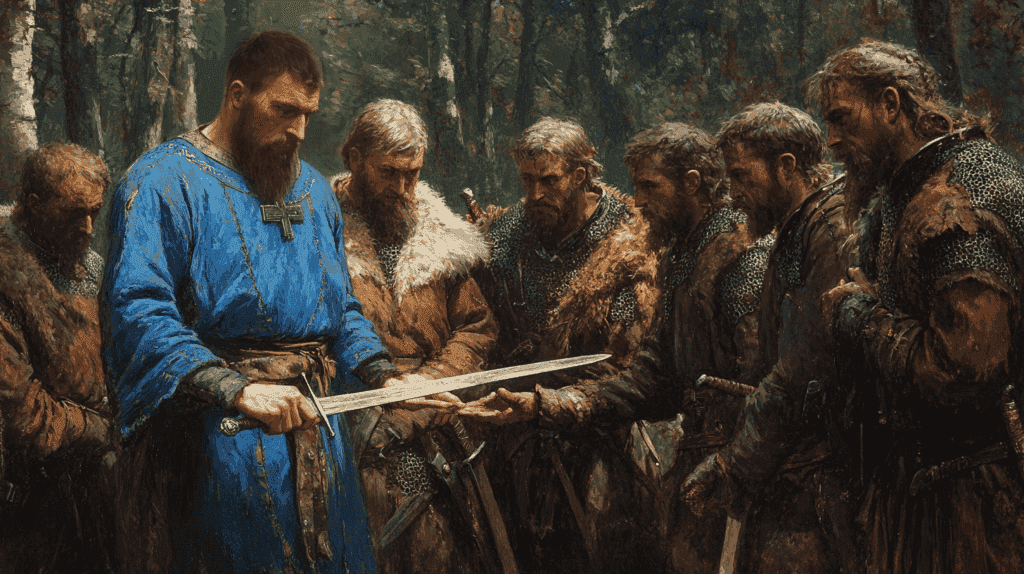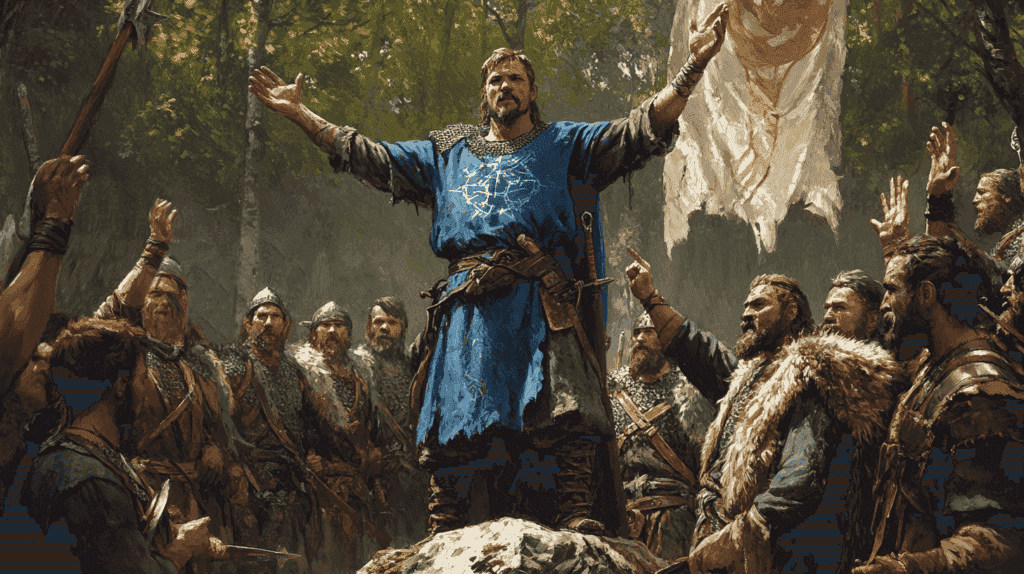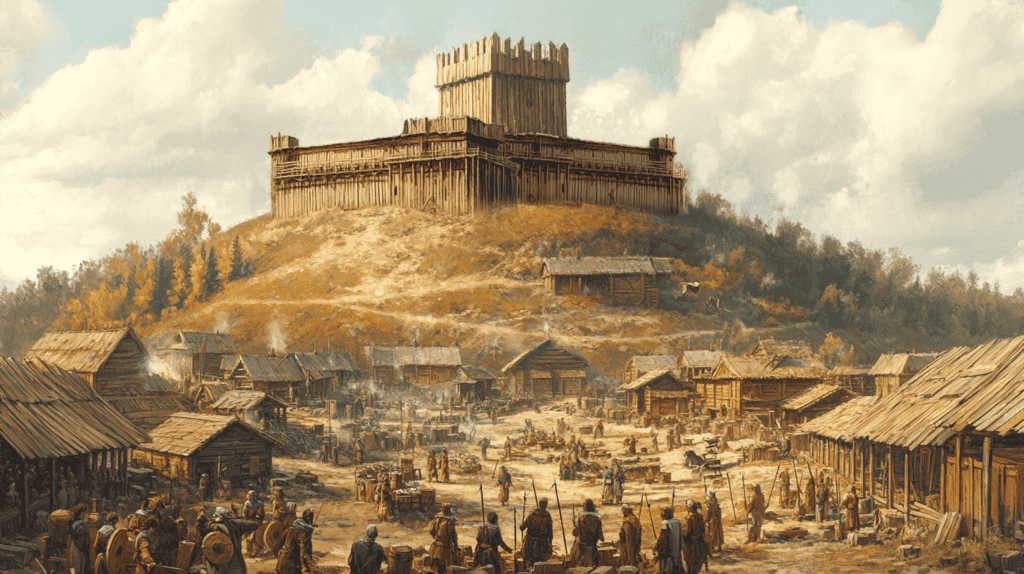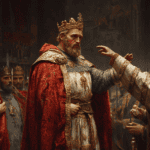
In the early 7th century, a remarkable event unfolded in Central Europe that would shape the course of Slavic history. In 623 CE, a Frankish merchant named Samo rose to power and established the first known Slavic state, marking a pivotal moment in the region’s political landscape.
The Rise of Samo
Samo, believed to have been born around 600 CE, was a Frankish merchant who traveled to Slavic lands in Central Europe. Samo was possibly a Slavic noble hostage as a boy in the Frankish Empire and trained in their army, much like Arminius in Rome, but his beginnings are shrouded in mystery. What is known is that his journey eastward coincided with a tumultuous period in the region’s history, as Slavic tribes were struggling against the oppressive rule of the Avars.
The Avars, a nomadic people of Eurasian origin, had established dominance over much of Central Europe in the late 6th century. They subjugated local Slavic populations, imposing harsh rule and demanding tribute. This oppression created a volatile situation ripe for rebellion.
The Slavic Rebellion
According to the Chronicles of Fredegar, the primary historical source for this period, Samo arrived among the Slavs around 623-624 CE. The exact timing of his arrival has been subject to debate among historians, with some suggesting it may have occurred slightly later, following the Avar defeat at the First Siege of Constantinople in 626 CE.
Regardless of the precise date, Samo’s arrival coincided with a significant Slavic uprising against Avar rule. The Frankish merchant, possibly involved in the arms trade, supplied weapons to the rebelling Slavs. However, Samo’s role quickly evolved from that of a merchant to a military leader.

Military Prowess and Leadership
Samo demonstrated exceptional military acumen and leadership skills during the rebellion. He personally led Slavic forces in battle against the Avars, achieving a string of impressive victories. These successes not only liberated many Slavic tribes from Avar control but also showcased Samo’s strategic capabilities.
The Slavic tribes, impressed by Samo’s bravery and command skills, made an unprecedented decision. In recognition of his crucial role in their liberation and his proven leadership abilities, they elected Samo as their king, bestowing upon him the title “Rex Sclavorum” (King of the Slavs).
The political entity that emerged under Samo’s rule is often referred to as “Samo’s Empire,” though terms like “realm,” “kingdom,” or “tribal union” are also used. This state represented the first recorded political union of Slavic tribes, marking a significant milestone in Slavic history.

Territorial Extent
The exact boundaries of Samo’s realm remain a subject of historical debate due to limited contemporary sources. However, it is generally believed to have encompassed a substantial territory in Central Europe. Samo’s domain likely included:
- Moravia (in the present-day Czech Republic)
- Bohemia (also in the Czech Republic)
- Parts of Lower Austria
- Parts of Carinthia (in modern Austria)
- Portions of Slovenia and Slovakia
Some sources suggest that at its peak, Samo’s realm may have stretched from the Eastern Tatra Mountains to the Western Šumava Mountains, and from the southern Sprewa and Havel rivers to the Krkonoše Mountains.
Governance and Structure
While details of Samo’s governance are scarce, it appears that he ruled from a seat of power at Vyšehrad, an ancient fort that later became an important site in Czech history. The structure of his realm was likely a confederation of Slavic tribes, united under Samo’s leadership but retaining significant autonomy.
Samo consolidated his rule through a combination of military success, diplomatic skill, and strategic marriages. He is reported to have married at least twelve women from prominent Slavic families, fathering twenty-two sons and fifteen daughters. These marriages served to strengthen alliances and integrate various tribal groups into his realm.

The Battle of Wogastisburg
The most famous event of Samo’s reign, and a defining moment for his empire, was the Battle of Wogastisburg in 631 CE. This conflict pitted Samo’s forces against the Frankish kingdom led by King Dagobert I.
The rise of a powerful Slavic state on the eastern borders of the Frankish realm was a source of concern for Dagobert I. The Frankish king sought to assert his authority over the region and possibly viewed Samo’s realm as a threat to Frankish interests.
The immediate pretext for war came when Dagobert accused Samo’s subjects of attacking Frankish merchants. He sent an envoy named Sichar to demand compensation from Samo. When this diplomatic approach failed, Dagobert decided on military action.
The Battle
Dagobert I led a large Frankish force, reportedly consisting of three armies, against Samo’s realm. The decisive battle took place at a location called Wogastisburg, the exact site of which remains unknown to modern historians.
The battle lasted for three days, showcasing the determination of both sides. Despite facing a numerically superior Frankish force, Samo’s army demonstrated exceptional skill and tenacity.

In a stunning victory, Samo’s forces decisively defeated the Frankish army. The Franks suffered heavy casualties and were forced to retreat, with survivors fleeing the battlefield. This victory had far-reaching consequences:
- It solidified Samo’s position as a powerful ruler in Central Europe.
- It demonstrated the military capabilities of the Slavic forces under unified leadership.
- It prevented Frankish expansion into Slavic territories.
- It encouraged other Slavic groups to join Samo’s realm.
Following the battle, a Slavic leader named Dervan (or Dervanus), who had previously been subordinate to the Franks, pledged allegiance to Samo. This further expanded Samo’s influence and the territorial extent of his realm. While later, in 641, the rebellious duke of Thuringia, Radulf, sought an alliance with Samo against his Frankish sovereign, Sigebert III.
Legacy and Historical Significance
Samo ruled his Slavic realm for 35 years, from 623 to 658 CE. His reign marked a crucial period in Slavic history, with lasting impacts on the region’s development.
Political
Samo’s empire represented the first recorded instance of a large-scale political organization among Slavic peoples. While it did not survive long after Samo’s death in 658 CE, it set an important precedent. The experience of unified rule under Samo likely influenced later Slavic state formations, such as Great Moravia in the 9th century.
Cultural
The period of Samo’s rule coincided with significant cultural developments among Slavic peoples. The unity provided by his realm may have contributed to the consolidation and spread of Slavic cultural practices and languages across a wider area.
Military
Samo’s military successes, particularly the victory at Wogastisburg, demonstrated the potential strength of unified Slavic forces. This legacy of resistance against external powers would resonate in Slavic historical memory for centuries to come.
Economic
As a former merchant, Samo likely understood the importance of trade. His realm may have facilitated increased economic interactions among Slavic tribes and with neighboring regions, potentially stimulating economic development.

Conclusion
The rise of Samo and the establishment of the first known Slavic state in 623 CE represent a crucial chapter in European history. From a Frankish merchant to the king of a vast Slavic realm, Samo’s story is one of remarkable political and military achievement.
His 35-year reign saw the unification of numerous Slavic tribes, successful resistance against both Avar and Frankish powers, and the creation of a political entity that would inspire future generations of Slavic leaders. While Samo’s empire did not long outlive its founder, its impact on the political, cultural, and historical landscape of Central Europe was profound and long-lasting.
The legacy of Samo serves as a testament to the potential of unity and effective leadership in shaping the course of history. As the first recorded ruler to unite diverse Slavic tribes under a single banner, Samo laid the groundwork for future Slavic states and played a pivotal role in the early medieval history of Central Europe





Samo byl pravděpodobně slovankým šlechtickým rukojmím jako chlapec ve Franské říši a vycvičen v armádě podobně jako Arminius v Římu. Musel být Slovan, jinak by se nejen nedomluvil s kmeny, které sjednocoval ale ani by nemohl být eŕespektován, kdyby mezi slovanskou šlechtu nepatřil. Jak jinak by za 2 roky mohl sjednotit slovanské kmeny a proč by ho jinak přijaly jako vl´ůdce ve válkách proti AVarům?
I have translated your comment as “Samo was probably a Slavic noble hostage as a boy in the Frankish Empire and trained in the army much like Arminius in Rome. He had to be a Slav, otherwise he would not only not have agreed with the tribes he was uniting, but he could not even be respected if he did not belong to the Slavic nobility. How else could he unite the Slavic tribes in 2 years and why else would they accept him as a leader in the wars against the AVars?”
Thank you for this – it is a fair point and I have amended the start of the article